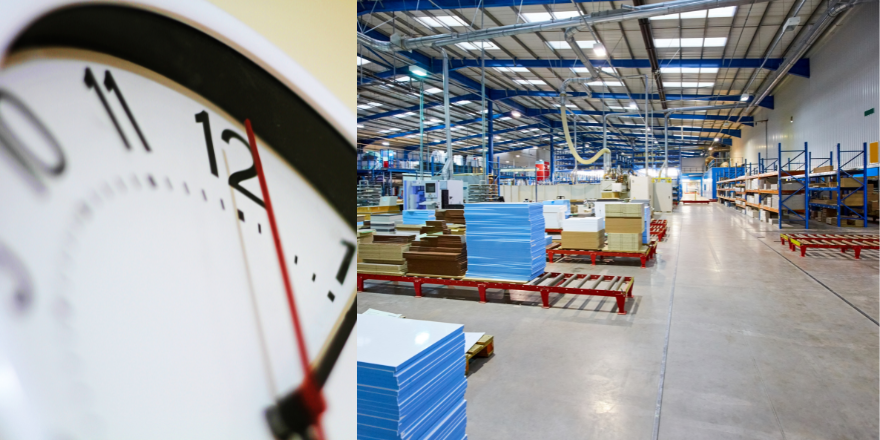
In Food and Beverage (F&B) manufacturing, the ability to optimize production sequences can make a significant impact on overall operational efficiency. One crucial aspect of this optimization is minimizing setup times. As a Production Scheduler in the F&B industry, you understand the critical role that setup times play in determining production output and resource utilization.
In this blog, we'll look into the strategies, tools, and technologies that can help you streamline production sequences and achieve substantial reductions in setup times. We'll also explore how integrating advanced planning and scheduling software like PlanetTogether with ERP, SCM, and MES systems can further enhance your capabilities.
The Significance of Setup Times
Setup times refer to the period required to prepare a manufacturing line or equipment for the production of a different product or batch. In the food and beverage industry, where product variety and freshness are critical, reducing setup times is paramount. Longer setups result in decreased productivity, increased operational costs, and potential delays in meeting customer demands. Optimizing production sequences to minimize these setup times can lead to enhanced efficiency, improved utilization of resources, and ultimately, increased profitability.
Challenges in Setup Time Reduction
Before looking into optimization strategies, it's essential to recognize the challenges associated with setup time reduction:
Complex Product Mix: F&B manufacturers often produce a wide range of products, each with unique requirements. Switching between products requires adjustments to equipment, recipes, and packaging.
Changeover Complexity: Setups involve multiple tasks, including equipment adjustments, cleaning, calibration, and more. Coordinating these tasks efficiently is challenging.
Resource Availability: Ensuring the availability of skilled technicians, operators, and tools during changeovers is crucial but can be difficult due to workforce constraints.
Minimizing Waste: Some setups result in waste, such as raw materials discarded during equipment purging. Balancing waste reduction with setup time reduction is a delicate task.
Unpredictable Demand: Rapid changes in market demand can necessitate frequent changeovers, demanding agility in production scheduling.
Optimization Strategies for Reduced Setup Times
Standardized Work Procedures: Documenting and standardizing setup procedures can help reduce variability and increase efficiency. Clear instructions ensure that tasks are performed consistently and correctly.
SMED (Single Minute Exchange of Die): This lean manufacturing technique focuses on minimizing setup times to a few minutes or even seconds. It involves categorizing tasks as internal (performed during machine downtime) or external (done while the machine is running) and optimizing them accordingly.
Pre-Staging: Prepare equipment, tools, and materials required for the next production run before the changeover. This minimizes downtime during the actual setup.
Parallelization: Identify tasks that can be performed simultaneously, such as cleaning one part of the machine while adjusting another. This approach reduces the overall changeover time.
Quick-Change Tooling: Implementing tooling and equipment designs that allow for rapid changeovers can significantly reduce setup times.
Cross-Training: Train operators and technicians to perform multiple tasks, enabling flexibility in resource allocation during changeovers.
Data-Driven Insights: Leverage historical data to identify patterns and bottlenecks in setup processes. Use this information to fine-tune your optimization strategies.
Integration between PlanetTogether and ERP/SCM/MES Systems
Integration between advanced planning and scheduling software like PlanetTogether and ERP, SCM, and MES systems enhances the ability to optimize production sequences and reduce setup times. Here's how:
Accurate Data Sharing: The integration between PlanetTogether and ERP/SCM/MES systems ensures that real-time data related to inventory levels, demand forecasts, and production schedules are shared seamlessly. This accurate data exchange forms the foundation for effective production scheduling.
Demand Forecasting: By accessing demand forecasts from ERP systems, PlanetTogether can anticipate production needs and schedule batches accordingly. This minimizes the need for frequent product changeovers, thus reducing setup times.
Resource Allocation: With data from MES and ERP systems, PlanetTogether can allocate resources efficiently. It considers factors such as machine availability, labor capacity, and material availability to create production schedules that minimize bottlenecks.
Optimized Sequencing: Leveraging advanced algorithms, PlanetTogether can create optimized production sequences that prioritize minimizing setup times. By grouping similar products together, it reduces the need for frequent equipment adjustments.
What-If Scenarios: Integration allows for "what-if" scenario analysis. Production Schedulers can simulate different scheduling strategies and assess their impact on setup times and overall efficiency.
Implementation Considerations
Data Accuracy: For successful integration, ensure that data in ERP, SCM, and MES systems is accurate and up-to-date. Inaccurate data can lead to suboptimal production sequences and increased setup times.
Customization: The integration may require customization to align with your specific production processes and business rules. Work closely with your IT and implementation teams to tailor the integration to your facility's needs.
Change Management: Implementing new software and integration processes requires change management. Train your teams on how to use the integrated system effectively to achieve the desired outcomes.
Optimizing production sequences for reduced setup times is a crucial goal in food and beverage manufacturing. By integrating PlanetTogether with leading ERP, SCM, and MES systems, Production Schedulers can achieve streamlined production processes, efficient resource allocation, and minimized setup times. This integration empowers manufacturers to stay competitive in a dynamic industry by responding swiftly to changing demands while maximizing operational efficiency.
Remember, the journey to reduced setup times is an ongoing process that requires continuous improvement. Embrace the power of integration and advanced scheduling tools to transform your production floor into a well-oiled machine that delivers quality products with remarkable efficiency.
Topics: Demand Forecasting, PlanetTogether Software, Resource Allocation, Integrating PlanetTogether, What-If Scenarios, Accurate Data Sharing, Optimized Sequencing




















LEAVE A COMMENT